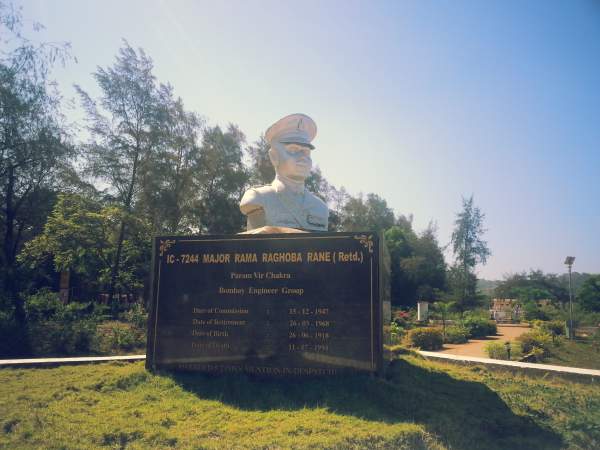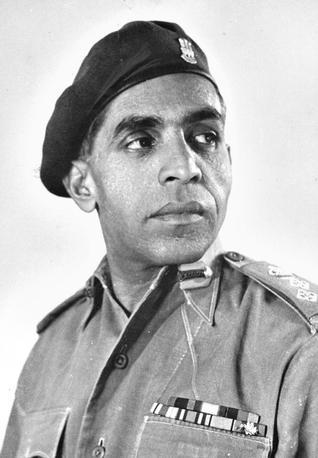
R Krishna Das
Prime Minister Narendra Modi today visited the frontline Nowshera sector in Jammu and Kashmir to celebrate Diwali with the Army personnel and recalled the contribution of Lieutenant Rama Raghoba Rane, country’s first living recipient of the Param Vir Chakra—India’s highest military decoration.
Lieutenant R R Rane, as Prime Minister addressed, was born on 26 June 1918 in the Chendia village, Karnataka in a Konkani speaking Maratha family. He was the son of Raghoba P Rane, a police constable. Rane served in the British Indian Army during the Second World War. He remained in the military during the post-war period and was commissioned in the Bombay Sappers Regiment of the Indian Army’s Corps of Engineers on 15 December 1947.
In April 1948, during the Indo-Pakistani War of 1947, Rane played a key role in the capture of Rajauri by Indian forces by being instrumental in clearing several roadblocks and minefields. His actions helped clear the way for advancing Indian tanks. He was awarded the Param Vir Chakra on 8 April 1948 for his gallantry. He retired as a major from the Indian Army in 1968. During his 28 years’ service with the army, he was mentioned in despatches five times. He died in 1994 at the age of 76.
On 18 March 1948, Jhangar, lost in December 1947 to the Pakistanis, was recaptured by troops of the Indian Army, which then started to move towards Rajouri from the Nowshera sector. On 8 April 1948, the 4th Dogra Battalion advanced to Rajauri. During the advance, the battalion attacked and captured the Barwali ridge, eleven kilometers to the north of Nowshera. The battalion’s advance beyond Barwali was obstructed by the increasing number of roadblocks and minefields. Supporting tanks were also unable to cross the obstacles.
Rane, in command of a section of the 37th Assault Field Company, attached to the 4th Dogra Battalion, was sent forward to help clear a path for the battalion. As Rane and his team started clearing a minefield, mortar fire from the Pakistanis killed two sappers and wounded five others, including Rane. Despite this, by the evening of 8 April, Rane and his surviving men cleared the minefield which enabled the supporting tanks to move forward. A safe lane still had to be prepared for the tanks as the road ahead was still dangerous; the Pakistani forces had yet to be cleared from the area. This lane was created by Rane through the night. The next day, his section worked for twelve continuous hours to clear mines and roadblocks. As the road was still too difficult to deal with, he made a diversion for the battalion to advance. Rane continued this work despite ongoing artillery and mortar fire from the Pakistanis.
On 10 April, Rane got up early and resumed work on an obstacle that had not been cleared the previous night. Within a span of two hours, he cleared the roadblock of five large pine trees in the midst of mines and machine-gun fire. This allowed the 4th Dogra Battalion to advance another thirteen kilometers until it encountered another major roadblock. The Pakistani forces were situated on the adjoining hills and able to fire on all approaches to the block, making its destruction problematic. Rane drove a tank to the roadblock and took cover behind the tank while blasting open the roadblock with mines, opening the road before the end of the night.
The next day, Rane worked for another seventeen hours to open the road to Chingas, which lay half-way between Rajouri and Naushahra on an old Mughal route, and beyond. During the period from 8 to 11 April, he had made a significant contribution in the Indian advance to Rajouri. His work not only cost the Pakistani forces about 500 dead and many more wounded, but also saved many civilians in the area from Chingas and Rajauri.
Prime Minister Narendra Modi also saluted the two bravehearts who sacrificed their lives for the motherland. They included Brigadier Mohammad Usman and Naik Jadunath Singh Rathore.

Brigadier Mohammad Usman (15 July 1912 – 3 July 1948) was the highest ranking officer of the Indian Army killed in action during the Indo-Pak war 1947. As a Muslim, Usman became a symbol of India’s inclusive secularism. At the time of the partition of India he with many other Muslim officers declined to move to the Pakistan Army and continued to serve with the Indian Army. He was killed in July 1948 while fighting Pakistani soldiers and militia in Jammu and Kashmir. He was later awarded the second highest military decoration for gallantry in the face of an enemy, the Maha Vir Chakra.

Jadunath Singh Rathore, (21 November 1916 – 6 February 1948) was an Indian Army soldier who was posthumously awarded the Param Vir Chakra, India’s highest military decoration for his actions in an engagement during the Indo-Pakistani War of 1947.
Singh was enlisted in the British Indian Army in 1941 and served in the Second World War, fighting against the Japanese in Burma. He later took part in the Indo-Pakistani War of 1947 as a member of the Indian Army. For an action on 6 February 1948 at Tain Dhar, to the north of Naushahra, Naik Singh was awarded the Param Vir Chakra.
Singh commanded a nine-man forward section post. Though heavily outnumbered by advancing Pakistani forces, Singh led his men in defending against three attempts to overtake the post. He was wounded during the second assault. Armed with a Sten gun, he single-handedly charged the third assault with such determination as to cause the attackers to withdraw. In doing so, he was killed. A sports stadium in Shahjahanpur and a crude oil tanker were named after Singh.



